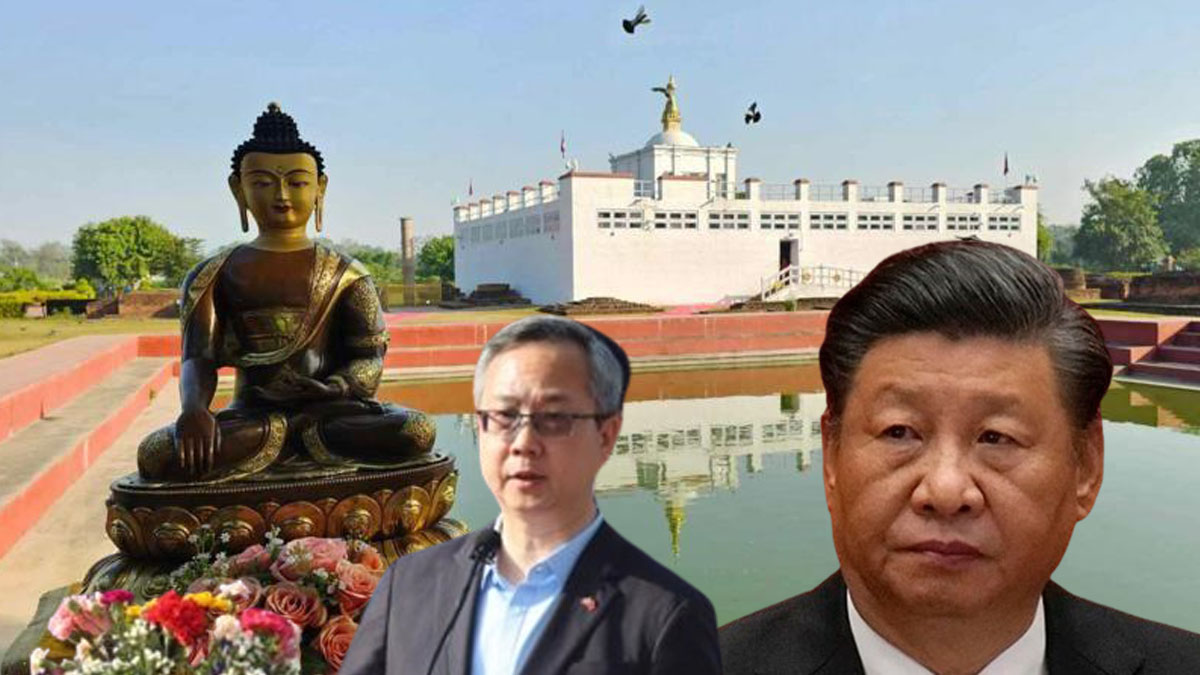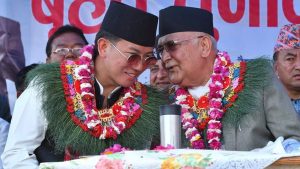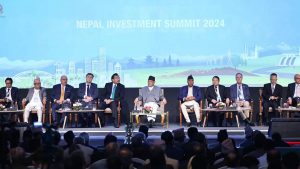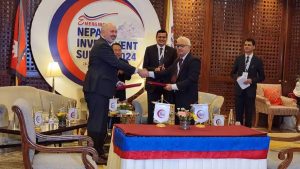
Lumbini Peace Festival: China’s Cultural Encroachment and Strategic Agenda
The Lumbini International Peace Festival, currently underway in Lumbini, has sparked concerns among foreign affairs experts, revealing China’s calculated interest in Buddha’s birthplace.
The festival, which kicked off on Friday, has shed light on Beijing’s escalating focus on Lumbini, particularly amidst recent political shifts in Nepal. Notably, Nepal opted to collaborate with the Chinese Embassy in Kathmandu for the festival, sidelining a previously planned conference involving Nobel laureates.
In a move raising eyebrows, Nepal postponed the conference last month amid internal power dynamics, opting instead for the collaboration with China for the peace festival.
Featuring meditation camps, peace concerts, and peace marathons, the two-day festival aligns with China’s broader diplomatic endeavors in Nepal. Analysts argue that China’s involvement in Lumbini aims to bolster its cultural influence within Buddhism globally, positioning itself as a significant player in the region’s affairs.
By aligning with events like the Lumbini International Peace Festival, China subtly advances its geopolitical interests while solidifying its foothold in Nepal, a move raising concerns among foreign observers.
What is Lumbini International Peace Festival 2024?
For the first time, an International Peace Fair is being held in Lumbini, the birthplace of Buddha, on April 5 and 6, making today the second day of the festival.
The festival is jointly organized by the Nepal Tourism Board, the Embassy of China in Nepal, the Lumbini Development Trust (LDT), and the Provincial Sports Council Lumbini. Additionally, the Nepal Overseas Chinese Association (NOCA), Lumbini-Based Zhong Hua Monastery, and Lumbini Hotel Association are listed as co-organizers. Supporting the event are Lumbini Buddhist University, Yunnan Mountaineering and Outdoor Sports Association, Lumbini Provincial Tourism Development Council, and Green Road.
Mani Lamichhame of Nepal Tourism Board emphasized that the program aims to promote tourism and economic prosperity through the publicity of Lumbini. The festival’s major events include the Lumbini International Peace Marathon, Lumbini International Meditation Day, and Lumbini Peace Concert.
The two-day event is being organized at the Lumbini Square, which is a UNESCO World Heritage Site. According to the organizers, 800 people, including monks and Buddhist pilgrims, participated in the meditation camp held on Friday. Stating that the program will be promoted worldwide, the organizers say that it will highlight the peace and cultural importance of Lumbini.
The symbolic meaning of the program
Some experts, following the Chinese festival in Lumbini, are linking the event to an international conference that was canceled last month.
The International Conference of Laureates and Leaders for Children, initially scheduled for March 11 and 12 in Lumbini, with the participation of former high-ranking officials and rights activists from Western countries, including some Nobel laureates, was postponed.
The organizers stated that they had planned to hold the conference at the invitation of the Lumbini province government, with support from the federal government of Nepal. However, the program was postponed due to the ‘political crisis’ that ensued after a shift in power dynamics in Nepal.
Some speculated that the Tibetan religious leader, the Dalai Lama, was also invited to the conference, leading to its postponement.
However, upon announcing the decision to relocate the conference to New Delhi, the organizers clarified that the Dalai Lama was never extended an invitation.
An analyst commented that while the exact reason for the postponement remains unknown, holding the conference in Nepal could significantly boost the promotion of Lumbini.
He states, “There are still many people who believe that Buddha was born in India. Some people are unaware of Lumbini. It needs greater recognition. Such programs are essential for raising awareness about Lumbini.”
The conference, which was to be organized under the leadership of Nobel laureate Kailash Satyarthi, had previously been postponed by the province government.
What does China want in Lumbini?
Some consider the timing of this program to be significant. After a shift in the power dynamics, Deputy Prime Minister and Foreign Minister Shrestha made Beijing his first foreign visit destination.
Experts suggest that China’s interest in Lumbini is not new. Amish Raj Mulmi, author of the book ‘All Roads Lead North’ on Nepal-China relations, states, “China’s interest in Lumbini isn’t recent. Previously, Prachanda attempted to involve an organization called the Asia Pacific Exchange and Cooperation Foundation (APEC). Geopolitical concerns arose then, with India expressing disagreement, leading to a halt. China has since expanded its cultural and people-to-people diplomacy in Nepal.”
Jhalanath Khanal, then Chairman of CPN-UML, led the government in 2011 when Prachanda claimed to have initiated a $3 billion investment for Lumbini’s development through APEC. Prachanda also served as vice-chairman of the Asia Pacific Exchange and Cooperation Foundation (APEC), a Hong Kong-based NGO, which faced controversy over its $3 billion Lumbini development plan.
Policymakers in New Delhi are closely monitoring Chinese interest in Lumbini, situated approximately 10 km from the Indian border, in recent years.
Dr. Nihar R. Nayak, a Research Fellow with the Manohar Parrikar Institute for Defence Studies and Analyses (MP-IDSA) in New Delhi, asserts that China has been attempting to maintain its influence in Lumbini while a coalition of left-wing parties is in power in Nepal.
“I think their interests are less cultural and religious,” he stated, “Rather, it is a matter of strategic interest. By engaging in Lumbini, they are seeking to address their regional insecurity.”
He believes that China’s interest in Lumbini is directed towards the Dalai Lama, who resides in exile in Tibet and Dharamsala.
Nayak explained, “When discussing Buddhism, traditionally China has not been a major player. Buddha was born in Nepal, attained enlightenment in India, and spent the final moments of his life there. China is attempting to assert control over Buddhism globally, hence their desire to increase influence over Lumbini. This is a way for them to demonstrate dominance over Buddhism internationally.”
Referring to India’s efforts to develop the Buddha Circuit by linking Lumbini, Nayak suggested that Delhi might be uneasy with China’s activities near its border.
He indicated that India is closely monitoring the ongoing events, stating, “For China, Lumbini is a strategic matter, whereas for India, it holds cultural significance. Additionally, for many, it’s an emotional subject as Buddha spent a considerable amount of time in India.”
Nayak added that the extent to which Nepal allows Chinese activities in its southern region will determine the situation, “If China transforms it into more of a security or strategic matter rather than a cultural one, and if their presence in Lumbini increases, then it could become a strategic concern for India as well.”
Author Amish Raj Mulmi believes that China’s growing interest in Lumbini is a reflection of China’s positioning as the world’s largest Buddhist country.
He said, “It seems that China is trying to present itself as a leader by focusing on Buddhism, the religion which is approved by China or Xi Jinping.”
What is the path Nepal should take?
In light of China’s escalating interest in Lumbini and its broader geopolitical implications, Nepal faces a crucial decision regarding the path forward. Balancing its sovereignty, cultural heritage, and strategic interests amidst competing regional dynamics presents a formidable challenge. Nepal must navigate this intricate landscape with prudence, safeguarding its autonomy while engaging constructively with external actors. A nuanced approach that prioritizes national interests, fosters regional cooperation, and preserves Lumbini’s sanctity as a symbol of global heritage is essential. By charting a careful course, Nepal can harness the potential of Lumbini as a beacon of peace and unity, while mitigating the risks posed by external pressures.















Comments